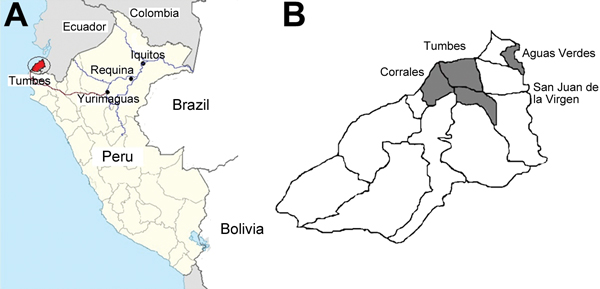Volume 21, Number 5—May 2015
Research
Molecular Epidemiology of Plasmodium falciparum Malaria Outbreak, Tumbes, Peru, 2010–2012
Figure 1

Figure 1. Peru, showing the department of Tumbes (black shading), the city of Iquitos, and the Requena district located in the Loreto region of the Peruvian Amazon (A) and the 13 districts in the department of Tumbes (B). Gray shading indicates the 4 districts (Tumbes, Corrales, Aguas Verdes, and San Juan de la Virgen) where the 210 cases were reported during the 2010–2012 outbreak of Plasmodium falciparum malaria; blue lines indicate travel routes by river; red line indicates travel route by road.
Page created: April 17, 2015
Page updated: April 17, 2015
Page reviewed: April 17, 2015
The conclusions, findings, and opinions expressed by authors contributing to this journal do not necessarily reflect the official position of the U.S. Department of Health and Human Services, the Public Health Service, the Centers for Disease Control and Prevention, or the authors' affiliated institutions. Use of trade names is for identification only and does not imply endorsement by any of the groups named above.